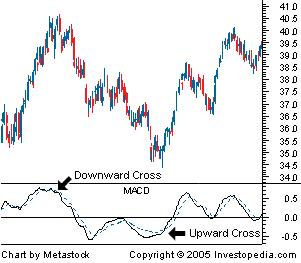Definition of 'Moving Average Convergence Divergence - MACD'
A trend-following momentum indicator that shows the
relationship between two moving averages of prices. The MACD is
calculated by subtracting the 26-day exponential moving average (EMA)
from the 12-day EMA. A nine-day EMA of the MACD, called the "signal
line", is then plotted on top of the MACD, functioning as a trigger for
buy and sell signals.
 |
|
|
Philippines News: FREE
Wednesday, March 19, 2014
Moving Average Convergence Divergence - MACD
Subscribe to:
Post Comments (Atom)
Labels
#SMPH
#SMPH #ALI #FLI #MEG
8990 Holdings
aboitiz group
Aboitiz Power
AC
AGI
ALI
Alliance global group inc
AP
AYALA
Ayala Corp
Ayala Land Inc
Banks
Belle Corp
Bloomberg
BPI
BSP
CEB
Cebu Pacific
Century Pacific Food Inc
Century Properties Group
CNPF
Col Financial
COL Model Portfolio
COLing the shots
COSCO
CPG
Credit Suisse
D&L
DD
DMCI
DNL
Double Dragon
EDC
EMP
ETF
FED
Filinvest Land Inc
First Philippine Holdings Corp
FLI
FMETF
FMIC
FPH
geri
GLO
Globe
GT Capital Holdings
GTCAP
House
ICT
ICTSI
IMI
IPO
JFC
JGS
Jollibee
LRW
LRWC
LTG
MARC
MBT
MEG
Megaworld Corporation
MER
Meralco
Metobank
Metro Pacific Investment Corp
mpi
MPIC
MWC
Pancake House
PCKH
PGOLD
Philippine Long Distance Telephone Co
Philippine Seven Corporation
Philippine Stock Exchange
Phoenix Petroleum
PLDT
PNB
PNX
PSB
PSE
PSEi
PSPC
purefoods
Puregold Price Club Inc
RFM
San Miguel Corporation
SEVN
SM
SMB
SMC
smph
Stock Market
Stocks
TEL
Universal Robina Corporation
URC

No comments:
Post a Comment